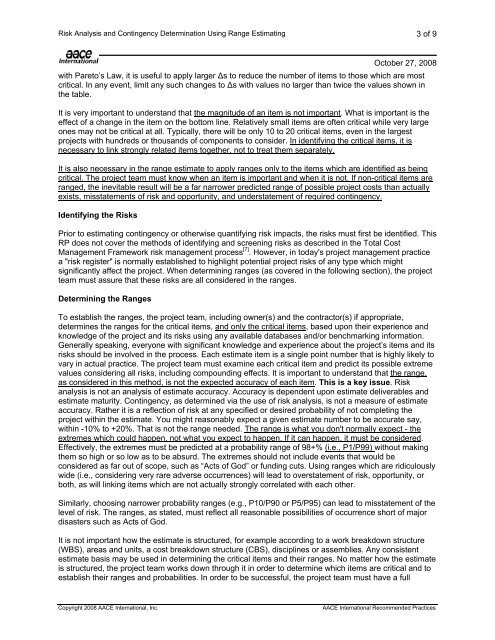154017221-41R-08-Risk-Analysis-and-Contingency-Determination-Using-Range-Estimating
Create successful ePaper yourself
Turn your PDF publications into a flip-book with our unique Google optimized e-Paper software.
<strong>Risk</strong> <strong>Analysis</strong> <strong>and</strong> <strong>Contingency</strong> <strong>Determination</strong> <strong>Using</strong> <strong>Range</strong> <strong>Estimating</strong><br />
3 of 9<br />
October 27, 20<strong>08</strong><br />
with Pareto’s Law, it is useful to apply larger Δs to reduce the number of items to those which are most<br />
critical. In any event, limit any such changes to Δs with values no larger than twice the values shown in<br />
the table.<br />
It is very important to underst<strong>and</strong> that the magnitude of an item is not important. What is important is the<br />
effect of a change in the item on the bottom line. Relatively small items are often critical while very large<br />
ones may not be critical at all. Typically, there will be only 10 to 20 critical items, even in the largest<br />
projects with hundreds or thous<strong>and</strong>s of components to consider. In identifying the critical items, it is<br />
necessary to link strongly related items together, not to treat them separately.<br />
It is also necessary in the range estimate to apply ranges only to the items which are identified as being<br />
critical. The project team must know when an item is important <strong>and</strong> when it is not. If non-critical items are<br />
ranged, the inevitable result will be a far narrower predicted range of possible project costs than actually<br />
exists, misstatements of risk <strong>and</strong> opportunity, <strong>and</strong> understatement of required contingency.<br />
Identifying the <strong>Risk</strong>s<br />
Prior to estimating contingency or otherwise quantifying risk impacts, the risks must first be identified. This<br />
RP does not cover the methods of identifying <strong>and</strong> screening risks as described in the Total Cost<br />
Management Framework risk management process [7] . However, in today's project management practice<br />
a "risk register" is normally established to highlight potential project risks of any type which might<br />
significantly affect the project. When determining ranges (as covered in the following section), the project<br />
team must assure that these risks are all considered in the ranges.<br />
Determining the <strong>Range</strong>s<br />
To establish the ranges, the project team, including owner(s) <strong>and</strong> the contractor(s) if appropriate,<br />
determines the ranges for the critical items, <strong>and</strong> only the critical items, based upon their experience <strong>and</strong><br />
knowledge of the project <strong>and</strong> its risks using any available databases <strong>and</strong>/or benchmarking information.<br />
Generally speaking, everyone with significant knowledge <strong>and</strong> experience about the project’s items <strong>and</strong> its<br />
risks should be involved in the process. Each estimate item is a single point number that is highly likely to<br />
vary in actual practice. The project team must examine each critical item <strong>and</strong> predict its possible extreme<br />
values considering all risks, including compounding effects. It is important to underst<strong>and</strong> that the range,<br />
as considered in this method, is not the expected accuracy of each item. This is a key issue. <strong>Risk</strong><br />
analysis is not an analysis of estimate accuracy. Accuracy is dependent upon estimate deliverables <strong>and</strong><br />
estimate maturity. <strong>Contingency</strong>, as determined via the use of risk analysis, is not a measure of estimate<br />
accuracy. Rather it is a reflection of risk at any specified or desired probability of not completing the<br />
project within the estimate. You might reasonably expect a given estimate number to be accurate say,<br />
within -10% to +20%. That is not the range needed. The range is what you don't normally expect - the<br />
extremes which could happen, not what you expect to happen. If it can happen, it must be considered.<br />
Effectively, the extremes must be predicted at a probability range of 98+% (i.e., P1/P99) without making<br />
them so high or so low as to be absurd. The extremes should not include events that would be<br />
considered as far out of scope, such as “Acts of God” or funding cuts. <strong>Using</strong> ranges which are ridiculously<br />
wide (i.e., considering very rare adverse occurrences) will lead to overstatement of risk, opportunity, or<br />
both, as will linking items which are not actually strongly correlated with each other.<br />
Similarly, choosing narrower probability ranges (e.g., P10/P90 or P5/P95) can lead to misstatement of the<br />
level of risk. The ranges, as stated, must reflect all reasonable possibilities of occurrence short of major<br />
disasters such as Acts of God.<br />
It is not important how the estimate is structured, for example according to a work breakdown structure<br />
(WBS), areas <strong>and</strong> units, a cost breakdown structure (CBS), disciplines or assemblies. Any consistent<br />
estimate basis may be used in determining the critical items <strong>and</strong> their ranges. No matter how the estimate<br />
is structured, the project team works down through it in order to determine which items are critical <strong>and</strong> to<br />
establish their ranges <strong>and</strong> probabilities. In order to be successful, the project team must have a full<br />
Copyright 20<strong>08</strong> AACE International, Inc.<br />
AACE International Recommended Practices



